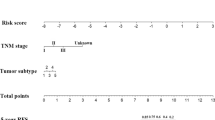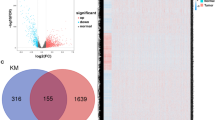Abstract
Purpose
The development of multi-gene signatures has led to improvements in identification of breast cancer patients at high risk of recurrence. The prognostic power of commercially available gene signatures is mostly restricted to estrogen receptor (ER)-positive breast cancer. On the contrary, immune-related gene signatures predict prognosis only in ER-negative breast cancer. This study aimed to develop a better prognostic signature for breast cancer.
Methods
The expressions of long non-coding RNA (lncRNA) genes from 30 independent microarray datasets with a total of 4813 samples were analyzed. A prognostic lncRNA signature was developed based on likelihood-ratio Cox regression analysis. Survival analysis was used to compare the prognostic efficiencies of our signature and 10 previously reported prognostic gene signatures.
Results
Cox regression analysis on 30 independent datasets showed that the 6-lncRNA signature identified in this study performed as well as five commercially available signatures in recurrence prediction for ER-positive breast cancer. In ER-negative breast cancer, this lncRNA signature was as prognostic as three immune-related gene signatures. Moreover, our lncRNA signature also demonstrated a good capacity to predict recurrence risk for triple-negative breast cancer. Function analysis showed that several lncRNAs in this signature were probably involved in cell proliferation and immune processes.
Conclusions
A six-LncRNA signature was identified that is prognostic for ER-positive, ER-negative, and triple-negative breast cancers and thus deserves further validation in prospective studies.






Similar content being viewed by others
References
van ’t Veer LJ, Dai H, van de Vijver MJ, et al (2002) Gene expression profiling predicts clinical outcome of breast cancer. Nature 415:530–536. https://doi.org/10.1038/415530a
Paik S, Shak S, Tang G et al (2004) A multigene assay to predict recurrence of tamoxifen-treated, node-negative breast cancer. N Engl J Med 351:2817–2826. https://doi.org/10.1056/NEJMoa041588
Sotiriou C, Wirapati P, Loi S et al (2006) Gene expression profiling in breast cancer: understanding the molecular basis of histologic grade to improve prognosis. J Natl Cancer Inst 98:262–272. https://doi.org/10.1093/jnci/djj052
Filipits M, Rudas M, Jakesz R et al (2011) A new molecular predictor of distant recurrence in ER-positive, HER2-negative breast cancer adds independent information to conventional clinical risk factors. Clin Cancer Res 17:6012–6020. https://doi.org/10.1158/1078-0432.CCR-11-0926
Parker JS, Mullins M, Cheang MCU et al (2009) Supervised risk predictor of breast cancer based on intrinsic subtypes. J Clin Oncol 27:1160–1167. https://doi.org/10.1200/JCO.2008.18.1370
Sgroi DC, Carney E, Zarrella E et al (2013) Prediction of late disease recurrence and extended adjuvant letrozole benefit by the HOXB13/IL17BR biomarker. J Natl Cancer Inst 105:1036–1042. https://doi.org/10.1093/jnci/djt146
Weigelt B, Pusztai L, Ashworth A, Reis-Filho JS (2011) Challenges translating breast cancer gene signatures into the clinic. Nat Rev Clin Oncol 9:58–64. https://doi.org/10.1038/nrclinonc.2011.125
Gingras I, Desmedt C, Ignatiadis M, Sotiriou C (2015) CCR 20th anniversary commentary: gene-expression signature in breast cancer—where did it start and where are we now? Clin Cancer Res 21:4743–4746. https://doi.org/10.1158/1078-0432.CCR-14-3127
Győrffy B, Hatzis C, Sanft T et al (2015) Multigene prognostic tests in breast cancer: past, present, future. Breast Cancer Res 17:11. https://doi.org/10.1186/s13058-015-0514-2
Huarte M (2015) The emerging role of lncRNAs in cancer. Nat Med 21:1253–1261. https://doi.org/10.1038/nm.3981
Wilson CL, Miller CJ (2005) Simpleaffy: a BioConductor package for Affymetrix Quality Control and data analysis. Bioinformatics 21:3683–3685. https://doi.org/10.1093/bioinformatics/bti605
Johnson WE, Li C, Rabinovic A (2007) Adjusting batch effects in microarray expression data using empirical Bayes methods. Biostatistics 8:118–127. https://doi.org/10.1093/biostatistics/kxj037
Zhu X, Tian X, Yu C et al (2016) A long non-coding RNA signature to improve prognosis prediction of gastric cancer. Mol Cancer. https://doi.org/10.1186/s12943-016-0544-0
Alaei S, Sadeghi B, Najafi A, Masoudi-Nejad A (2019) LncRNA and mRNA integration network reconstruction reveals novel key regulators in esophageal squamous-cell carcinoma. Genomics 111:76–89. https://doi.org/10.1016/j.ygeno.2018.01.003
Volders P-J, Verheggen K, Menschaert G et al (2015) An update on LNCipedia: a database for annotated human lncRNA sequences. Nucleic Acids Res 43:D174–D180. https://doi.org/10.1093/nar/gku1060
Meng J, Li P, Zhang Q et al (2014) A four-long non-coding RNA signature in predicting breast cancer survival. J Exp Clin Cancer Res 33:84. https://doi.org/10.1186/s13046-014-0084-7
Sánchez Y, Segura V, Marín-Béjar O et al (2014) Genome-wide analysis of the human p53 transcriptional network unveils a lncRNA tumour suppressor signature. Nat Commun 5:5812. https://doi.org/10.1038/ncomms6812
Li J, Wang W, Xia P et al (2018) Identification of a five-lncRNA signature for predicting the risk of tumor recurrence in patients with breast cancer. Int J Cancer 143:2150–2160. https://doi.org/10.1002/ijc.31573
Zhou M, Zhong L, Xu W et al (2016) Discovery of potential prognostic long non-coding RNA biomarkers for predicting the risk of tumor recurrence of breast cancer patients. Sci Rep 6:31038. https://doi.org/10.1038/srep31038
Beck D, Thoms J, a. I, Palu C, et al (2018) A four-gene LincRNA expression signature predicts risk in multiple cohorts of acute myeloid leukemia patients. Leukemia 32:263–272. https://doi.org/10.1038/leu.2017.210
Mao X, Qin X, Li L et al (2018) A 15-long non-coding RNA signature to improve prognosis prediction of cervical squamous cell carcinoma. Gynecol Oncol 149:181–187. https://doi.org/10.1016/j.ygyno.2017.12.011
Haibe-Kains B, Desmedt C, Loi S et al (2012) A three-gene model to robustly identify breast cancer molecular subtypes. J Natl Cancer Inst 104:311–325. https://doi.org/10.1093/jnci/djr545
Desmedt C, Haibe-Kains B, Wirapati P et al (2008) Biological processes associated with breast cancer clinical outcome depend on the molecular subtypes. Clin Cancer Res 14:5158–5165. https://doi.org/10.1158/1078-0432.CCR-07-4756
Teschendorff AE, Miremadi A, Pinder SE et al (2007) An immune response gene expression module identifies a good prognosis subtype in estrogen receptor negative breast cancer. Genome Biol 8:R157. https://doi.org/10.1186/gb-2007-8-8-r157
Ignatiadis M, Singhal SK, Desmedt C et al (2012) Gene modules and response to neoadjuvant chemotherapy in breast cancer subtypes: a pooled analysis. J Clin Oncol 30:1996–2004. https://doi.org/10.1200/JCO.2011.39.5624
Criscitiello C, Bayar MA, Curigliano G et al (2018) A gene signature to predict high tumor-infiltrating lymphocytes after neoadjuvant chemotherapy and outcome in patients with triple-negative breast cancer. Ann Oncol 29:162–169. https://doi.org/10.1093/annonc/mdx691
Bild AH, Yao G, Chang JT et al (2006) Oncogenic pathway signatures in human cancers as a guide to targeted therapies. Nature 439:353–357. https://doi.org/10.1038/nature04296
Gatza ML, Lucas JE, Barry WT et al (2010) A pathway-based classification of human breast cancer. Proc Natl Acad Sci USA 107:6994–6999. https://doi.org/10.1073/pnas.0912708107
Chen JL-Y, Lucas JE, Schroeder T et al (2008) The genomic analysis of lactic acidosis and acidosis response in human cancers. PLoS Genet 4:e1000293. https://doi.org/10.1371/journal.pgen.1000293
Liu D, Zhou K (2019) BRAF/MEK pathway is associated with breast cancer in ER-dependent mode and improves ER status-based cancer recurrence prediction. Clinical Breast Cancer. https://doi.org/10.1016/j.clbc.2019.08.005
Liu D (2020) AR pathway activity correlates with AR expression in a HER2-dependent manner and serves as a better prognostic factor in breast cancer. Cell Oncol (Dordr) 43:321–333. https://doi.org/10.1007/s13402-019-00492-6
Liu D, Liu X, Xing M (2014) Activities of multiple cancer-related pathways are associated with BRAF mutation and predict the resistance to BRAF/MEK inhibitors in melanoma cells. Cell Cycle 13:208–219. https://doi.org/10.4161/cc.26971
Liu D (2019) Concomitant dysregulation of the estrogen receptor and BRAF/MEK signaling pathways is common in colorectal cancer and predicts a worse prognosis. Cell Oncol (Dordr) 42:197–209. https://doi.org/10.1007/s13402-018-00420-0
Liao Q, Liu C, Yuan X et al (2011) Large-scale prediction of long non-coding RNA functions in a coding-non-coding gene co-expression network. Nucleic Acids Res 39:3864–3878. https://doi.org/10.1093/nar/gkq1348
Huang DW, Sherman BT, Lempicki RA (2009) Bioinformatics enrichment tools: paths toward the comprehensive functional analysis of large gene lists. Nucleic Acids Res 37:1–13. https://doi.org/10.1093/nar/gkn923
Zhang G, Xu Y, Wang S et al (2019) LncRNA SNHG17 promotes gastric cancer progression by epigenetically silencing of p15 and p57. J Cell Physiol 234:5163–5174. https://doi.org/10.1002/jcp.27320
Xu T, Yan S, Jiang L et al (2019) Gene amplification-driven long noncoding RNA SNHG17 regulates cell proliferation and migration in human non-small-cell lung cancer. Mol Ther Nucleic Acids 17:405–413. https://doi.org/10.1016/j.omtn.2019.06.008
Wang Z, Katsaros D, Biglia N et al (2019) ERα upregulates the expression of long non-coding RNA LINC00472 which suppresses the phosphorylation of NF-κB in breast cancer. Breast Cancer Res Treat 175:353–368. https://doi.org/10.1007/s10549-018-05108-5
Zou A, Liu X, Mai Z et al (2019) LINC00472 acts as a tumor suppressor in NSCLC through KLLN-mediated p53-signaling pathway via MicroRNA-149-3p and MicroRNA-4270. Mol Ther Nucleic Acids 17:563–577. https://doi.org/10.1016/j.omtn.2019.06.003
Fan C, Oh DS, Wessels L et al (2006) Concordance among gene-expression-based predictors for breast cancer. N Engl J Med 355:560–569. https://doi.org/10.1056/NEJMoa052933
Prat A, Parker JS, Fan C et al (2012) Concordance among gene expression-based predictors for ER-positive breast cancer treated with adjuvant tamoxifen. Ann Oncol 23:2866–2873. https://doi.org/10.1093/annonc/mds080
Lundberg A, Lindström LS, Harrell JC et al (2017) Gene Expression Signatures and Immunohistochemical Subtypes Add Prognostic Value to Each Other in Breast Cancer Cohorts. Clin Cancer Res 23:7512–7520. https://doi.org/10.1158/1078-0432.CCR-17-1535
Buechler SA, Gökmen-Polar Y, Badve SS (2019) EarlyR: a robust gene expression signature for predicting outcomes of estrogen receptor-positive breast cancer. Clin Breast Cancer 19:17–26.e8. https://doi.org/10.1016/j.clbc.2018.07.011
Acknowledgements
The results here are mainly based upon the breast cancer microarray data from public repositories. We are very grateful to the investigators who contributed these microarray datasets to the public domain.
Author information
Authors and Affiliations
Corresponding author
Ethics declarations
Conflict of interest
Bluewater Biotech LLC has filed a provisional patent for the results in this paper. Dingxie Liu has an equity interest in Bluewater Biotech LLC.
Ethical approval
This article does not contain any studies with human participants or animals performed by any of the authors.
Informed consent
Informed consent was obtained from all individual participants included in the study.
Additional information
Publisher's Note
Springer Nature remains neutral with regard to jurisdictional claims in published maps and institutional affiliations.
Electronic supplementary material
Below is the link to the electronic supplementary material.
Rights and permissions
About this article
Cite this article
Liu, D. Identification of a prognostic LncRNA signature for ER-positive, ER-negative and triple-negative breast cancers. Breast Cancer Res Treat 183, 95–105 (2020). https://doi.org/10.1007/s10549-020-05770-8
Received:
Accepted:
Published:
Issue Date:
DOI: https://doi.org/10.1007/s10549-020-05770-8




